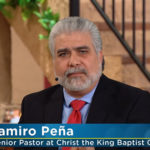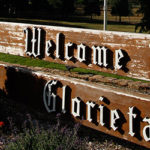DALLAS—Parallel forces both help and hinder Baptist churches that try to reach young Hispanic adults, a Texas Baptist leader told workshop participants at the Cooperative Baptist Fellowship general assembly.
Jesse Rincones, executive director of the Hispanic Baptist Convention of Texas.On the one hand, the further Hispanics move from immigration—second and third generations born in the United States—the less they identify with the cultural Catholicism of their family’s Latin American homeland, said Jesse Rincones, executive director of the Hispanic Baptist Convention of Texas.
“They feel less pressure from their family, from their community” to identify as Roman Catholic, he noted.
On the other hand, the faith of Hispanic Millennials—who have come of age since 2000—mirrors religious trends among society at large, Rincones added. Nationally, the fastest-growing religious identification among their age cohort is the “nones,” who express no religious affiliation.
Rincones cited a nationwide survey of Hispanics in the United States, conducted by the Barna Group. Among first-generation Hispanics, 72 percent identify as Catholic, and 16 percent call themselves Protestant. But among third-generation Hispanics, the numbers shift to 65 percent Catholic and 21 percent Protestant.
Sixty-two percent of Hispanics in the United States are second- and third-generation, he reported, adding 88 percent of those generations are children under age 18.
Baptists who want to reach Hispanics can build off a strong cultural tendency, he said.
Hispanics respect faith
“Hispanics respect faith,” he explained. But “integrating that faith in their practices is something they have yet to do.”
Sign up for our weekly edition and get all our headlines in your inbox on Thursdays
For example, the Barna research shows Hispanics “disassociate money and faith,” he said. “The church and the Bible are not primary sources for (determining how to handle) finances.”
Similarly, most Hispanics are proud of their work and see it as improving the world, adding meaning to life and contributing to American society, but it is not connected to their faith, Rincones added.
And while Hispanics often are pictured as socially conservative and thus place a strong emphasis on family, “the church is not a primary source of reference for families,” he said.
While a Bible is in the homes of 83 percent to 85 percent of Hispanics, only 8 percent of them reported reading it at least four times a week, he said.
“If they’re not in the Scripture, they’re not going to see the connection between their faith, family and finances,” he warned.
Language no longer a challenge
While language once provided a huge challenge for Hispanic congregations, that’s no longer the case, he noted.
“Before churches had their worship wars, many of our churches had their language wars” over whether to speak Spanish or English in worship, he said. And that challenge wasn’t unique to Baptists, he observed, citing conversations with Catholics and Mormons whose Hispanic congregations struggled with which language to use in worship.
“Now, our challenges no longer are over language, but culture,” he said. Even English-fluent congregations struggle with an Anglo emphasis on time and structured worship.
He illustrated by describing how English-speaking young Hispanics often chafe when others start and stop events according to the clock. He also told how some well-educated Hispanics who are integrated into U.S. business feel bound by worship that is not “free” and exuberant.
Consequently, “large shares of native-born Latinos as well as those who speak little or no Spanish … report attending churches with ethnic characteristics,” he said.
Whatever the challenges, reaching second- and third-generation Hispanics with the gospel is vital, Rincones stressed. And those generations are huge, he added, explaining Texas Hispanics accounted for 49.3 percent of all U.S. growth of children under age 19 from 2000 to 2010.
He expressed optimism about the challenge of sharing the gospel with young Hispanics. “Churches are growing closer and closer to being able to reach this generation,” he said.
Speaking English while embracing Latin culture
Second- and third-generation Hispanics practice “selective assimilation,” he reported, noting young Hispanics increasingly speak English while embracing Latino culture. And they prefer churches that share their values.
For example, Spanish is the dominant language of 72 percent of first-generation Hispanics, while English is dominant for 78 percent of third-generation Hispanics. Culturally, young Hispanics mirror their non-Hispanic Millennial counterparts in the use of digital technology—texts, cell phones, social networking.
Rincones identified three types of churches needed to reach Hispanics:
• Distinctively Hispanic congregations. Most members are Hispanic, and both Spanish and bilingual services are offered. Two-thirds of Hispanics who go to church attend this kind of congregation, he said.
• English-speaking, Hispanic-culture churches. They accommodate Hispanics who are fluent in English but retain “the socio-cultural characteristics that motivate them to worship in these types of churches,” he explained.
• English-speaking congregations that are sensitive to Hispanic culture. “The more assimilated Hispanics feel more comfortable in that type of environment,” he said. “Many of them live and work alongside Anglos; therefore, going to church with them is very natural.”
Those factors call for cooperation among traditionally Hispanic and traditionally Anglo congregations, he said.
“The traditional First Baptist Church and the traditional Primera (Iglesia Bautista) may have to move toward each other,” he said. Hispanic churches can provide cultural connections, while the Anglo congregations offer resources and experience.
The challenge—and opportunity—is too great not to cooperate, Rincones insisted.














We seek to connect God’s story and God’s people around the world. To learn more about God’s story, click here.
Send comments and feedback to Eric Black, our editor. For comments to be published, please specify “letter to the editor.” Maximum length for publication is 300 words.